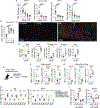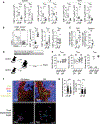The Bone Marrow Protects and Optimizes Immunological Memory during Dietary Restriction
- PMID: 31442402
- PMCID: PMC6818271
- DOI: 10.1016/j.cell.2019.07.049
The Bone Marrow Protects and Optimizes Immunological Memory during Dietary Restriction
Abstract
Mammals evolved in the face of fluctuating food availability. How the immune system adapts to transient nutritional stress remains poorly understood. Here, we show that memory T cells collapsed in secondary lymphoid organs in the context of dietary restriction (DR) but dramatically accumulated within the bone marrow (BM), where they adopted a state associated with energy conservation. This response was coordinated by glucocorticoids and associated with a profound remodeling of the BM compartment, which included an increase in T cell homing factors, erythropoiesis, and adipogenesis. Adipocytes, as well as CXCR4-CXCL12 and S1P-S1P1R interactions, contributed to enhanced T cell accumulation in BM during DR. Memory T cell homing to BM during DR was associated with enhanced protection against infections and tumors. Together, this work uncovers a fundamental host strategy to sustain and optimize immunological memory during nutritional challenges that involved a temporal and spatial reorganization of the memory pool within "safe haven" compartments.
Copyright © 2019 Elsevier Inc. All rights reserved.
Figures






Comment in
-
When Fasting Gets Tough, the Tough Immune Cells Get Going-or Die.Cell. 2019 Aug 22;178(5):1038-1040. doi: 10.1016/j.cell.2019.07.052. Cell. 2019. PMID: 31442398 Free PMC article.
-
Fast tracking immunity.Nat Rev Immunol. 2019 Oct;19(10):598. doi: 10.1038/s41577-019-0219-3. Nat Rev Immunol. 2019. PMID: 31477874 No abstract available.
-
Bone Marrow: An Immunometabolic Refuge during Energy Depletion.Cell Metab. 2019 Oct 1;30(4):621-623. doi: 10.1016/j.cmet.2019.08.022. Cell Metab. 2019. PMID: 31577929
References
-
- Aramburu J, Ortells MC, Tejedor S, Buxadé M, and Lόpez-Rodríguez C. (2014). Transcriptional regulation of the stress response by mTOR. Sci. Signal. 7, re2. - PubMed
-
- Arojo OA, Ouyang X, Liu D, Meng T, Kaech SM, Pereira JP, and Su B. (2018). Active mTORC2 Signaling in Naive T Cells Suppresses Bone Marrow Homing by Inhibiting CXCR4 Expression. J. Immunol. 201, 908–915. - PubMed
-
- Becker TC, Coley SM, Wherry EJ, and Ahmed R. (2005). Bone marrow is a preferred site for homeostatic proliferation of memory CD8 T cells. J. Immunol. 174, 1269–1273. - PubMed
Publication types
MeSH terms
Substances
Grants and funding
LinkOut - more resources
Full Text Sources
Other Literature Sources
Molecular Biology Databases

